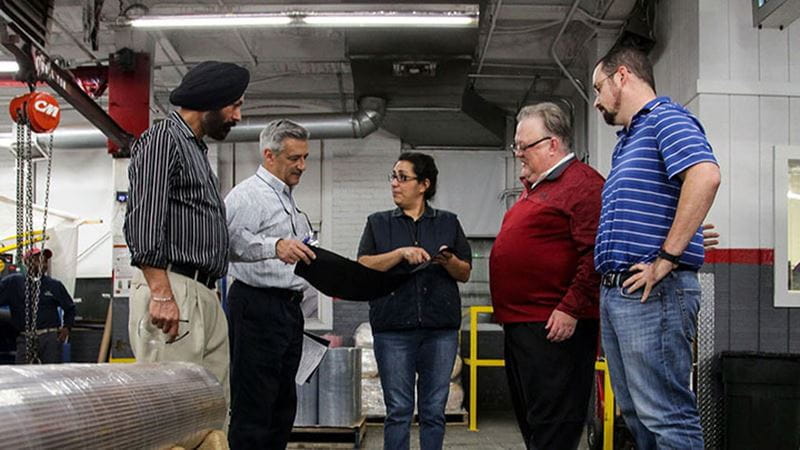Pushing the envelope

A hospital stay is inherently filled with stresses and concerns, but Trelleborg helps ensure that medical facilities have the latest in technologies available to keep you safe and secure. It’s reassuring to know that when you’re shown to your room, you can count on a clean, germ-free bed to rest in while you endure the medical procedures you’d rather avoid.
John Mouland, Technical Director, and his development team within Trelleborg Coated Systems work to create mattress covers that remain impermeable to fluids and germs and prevent cross-contamination from the illnesses patients bring to hospital environments.
“Our coated fabrics use polyurethane coatings to exclude unwanted media so that it does not penetrate into the bed,” he says. “I’ve been with Trelleborg since 1998, working with the production and new product development teams, taking our work within the laboratory and helping implement this into production to meet customer demands.”
Mouland’s team, based in New Haven, Connecticut, in the U.S., applies these technologies to a variety of fabrics for the healthcare & medical and aerospace industries,
as well as for consumer and recreational products. “Our fabrics are used within a wide variety of industries, so we’re dealing with a lot of different fabrics,” Mouland says. “Fortunately, here at Trelleborg, making coated fabrics of the highest quality is of the utmost importance. Customers bring us their ideas and specifications,
and we work with them to meet their needs.”
One recent application was to create coatings for survival gear worn by workers being transported by helicopter to remotely located oil rigs. They need to wear survival
suits designed to protect them in case of an accident that might drop them into icy Arctic waters, keeping them warm, dry and safe until they are rescued from the sea.
Camping gear is yet another popular application. In addition, Mouland says his team is working to improve lighter-than-air ships such as blimps.
“The material requirements can push the envelope in production,” he says. “If it were easy, then everybody could do it, but if it’s difficult and we succeed in solving the problem, we help our customers be at the top of their field. It can be challenging to find the weight and strengths needed.
“Sometimes it’s about the feel of the fabric. It might need to feel softer for a customer’s application. Or they might require a soft fabric that also has a lot of adhesion.
Occasionally these needs go against each other, and there is always the possibility that the customer’s needs change as we are mid-development on their product. Trelleborg has been in the engineered coated fabric business for more than 40 years, so we’ve earned a good reputation for meeting our customers’ demands.”
As a Global Key Account Manager within Trelleborg Coated Systems, Dan Culhane connects with customers to uncover needs that Trelleborg products and solutions
can deliver. Currently Culhane is working with customers to see that tourniquets used in surgeries and emergency situations remain reliably in place to arrest bleeding – combating an issue that occurs when a tourniquet slips out of place. Another customer is seeking a bariuminfused fabric for use under X-ray that will shine during laparoscopic surgeries and identify the exact location of the device during surgical procedures.
“Whether at the physician or production level, the biggest challenges in the medical industry are enhancing functionality, making existing products better and improving performance without compromising capability with the product itself – all while ensuring environmental safety,” Culhane says. “With coated fabrics, the demand in the healthcare & medical industry is to provide more durable and cleanable materials to be both infection- and fire-resistant, while still aesthetically pleasing. You need everything to last and to be chemically resistant. It’s a challenge to meet all those needs.”
Culhane says it’s the talent of the team at Trelleborg that brings success to the company and his own work. “We have a great development team that walks through a five-step process to define the project requirements and to create the most successful products for each application,” he says. “We work with our customers to agree on the specific parameters required, and then our development team comes up with the concept and timeline. They analyze the physical properties and chemistry needed, and they prototype a sample material for the customer to run their performance tests on. The final step is commercialization. Sometimes it can take two to three years for product development and FDA approval.
“Development is really where Trelleborg excels,” Culhane concludes.
For more information, please go to:
http://www.trelleborg.com/en/engineered-coated-fabrics
This is an article has been reproduced from Trelleborg's T-Time magazine. To download the latest edition, go to: www.trelleborg.com/t-time
Press Service: This article is available in eight languages. Media are welcome to use this article in their own publications. To download the article and pictures in any language go to https://bamboo-contentpartner.com/. If you reproduce information from this release, please give contact details as: www.trelleborg.com.